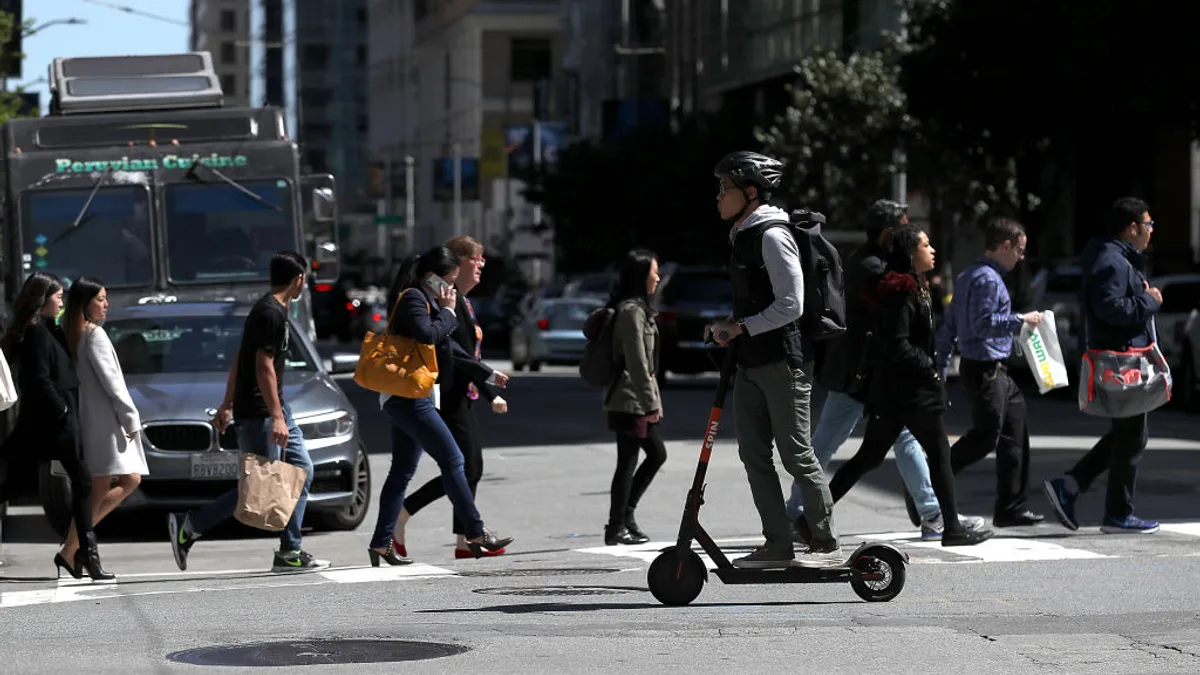Dive Brief:
- Real estate in walkable urban areas continues to see significant demand, which may inspire policies and investments aimed at developing more walkable neighborhoods, according to a report Wednesday that ranks walkable urbanism in the United States’ largest metro areas.
- The report, from nonprofit Smart Growth America and real estate information services company Places Platform, listed New York; Boston; Washington, D.C.; Seattle and Portland, Oregon, as the metro areas with the real estate mixes with the greatest walkability. Many of those metro areas were highlighted in iterations of the report prior to the pandemic, too.
- To spur walkability and equitable access to walkable areas, cities can advance zoning reform, foster non-car transportation options, preserve and invest in affordable housing, and plan for walkable neighborhoods to be resilient to climate impacts, the report states.
Dive Insight:
The organizations described this as “the first major study” looking at the real estate market in walkable urban areas after the pandemic disruption. One signal of people’s desire to be in walkable neighborhoods is a 34% price premium per square foot in housing for sale in such areas, they reported. While it’s well documented that many office-dominated downtown economies have suffered amid remote and hybrid work trends, walkable urban neighborhoods and urbanizing suburbs grew during that period, “demonstrating a preference for walkable places beyond the traditional downtown.”
“The so-called ‘death of the city’ has been overstated, again, as walkable urban price premiums and increased market share of office, retail, multi-family rentals and for-sale housing real estate in walkable urban places held up, despite impacts from the pandemic,” said Christopher Leinberger, managing director at Places Platform, in a statement Wednesday. “These findings provide a strong economic base and cement walkable urban places and development as the wave of the future as we move toward a more connected, environmentally-sustainable way of life.”
Perhaps surprisingly, Los Angeles — well known for its many freeways and car culture, researchers acknowledged — was No. 8 in the rankings. “However, it is the most densely populated metro in the U.S. and there is an understanding that they have reached the limit of freeway expansion as a part of their transportation system,” the report states. LA has turned to investment in regional transit and a return to downtown walkable urban development, according to the report.
The researchers also considered social equity, factoring in affordability, transit, and proximity to walkability for different socioeconomic and racial groups. Demand drives up costs and can reduce low- and moderate-income households’ opportunity to live in highly walkable areas. While metro areas like Los Angeles ranked lower in this regard, not all metro areas showed an inherent tradeoff between walkability and equitable access. New York and Washington, D.C., ranked in the top 10 on both walkable urbanism and social equity, Smart Growth America and Places Platform reported.
The organizations that produced the report stated that 19.1% of the total U.S. real GDP and 6.8% of the nation’s population are in walkable urban places that cover 1.2% of the total land mass of the top 35 metro areas. Yet, “it is illegal to build walkable urban densities and mixed-use development on much of the 98.8% of land that is car-dependent due to restrictive zoning policies in most metropolitan areas,” they stated. They point to zoning reform as an avenue for change.











